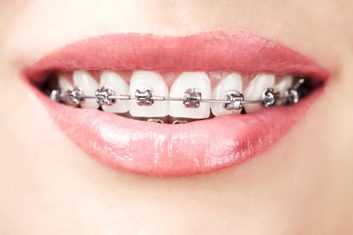Straighten your teeth with these braces options for adults
Braces aren’t just for kids. Adults looking for straighter teeth can get them, too’and the options are wider than ever. Read our guide to find the right adult braces option for you, from Invisalign to classic metal braces

Used to be, a makeover was a new haircut and colour plus a makeup revamp. But since at-home bleaching kits put so much attention on our teeth, smile-fixers have begun to chew up the makeover landscape. And sometimes bleaching just isn’t enough. Sparkling, movie-star veneers are a quick solution, but if you want to work with what you’ve got, or you have biting issues, braces may be the smile-savers for you. Here’s what on the menu these days.
Invisalign
What they are: Clear, molded plastic upper- and lower-teeth trays that fit your teeth through each straightening stage, which is about two weeks per set. The number of trays, or "aligners," depends on how much straightening you need.
Pros: The "sexy" version of traditional braces, they’re almost undetectable‘er, invisible’when you’re wearing them. Because they’re a smooth plastic, they shouldn’t irritate the insides of your mouth. You may have achy issues as your teeth begin to shift with each pair of aligners, but it usually doesn’t take long for you to adjust. They’re easy to clean, partly because you have to remove them before eating, and because they’re removable, you can brush and floss without issue. "In my practice, Invisalign is the most asked-about product when adults are investigating braces," says Dr. Stephen Gurza, orthodontist and founder of The Brace Place, which has offices in Toronto, Thornhill and Scarborough, Ont.
Cons: Not for folks with major straightening needs. As well, because the aligners are custom manufactured, you’re looking at some wait time between your fitting and delivery of your braces. If you require a replacement aligner because you’ve lost or damaged one, you’ll also have wait time because it can’t be fixed or supplied immediately by your orthodontist. Overall, you’ll find that Invisalign costs more than other options for adult braces.
Lingual braces
What they are: An at-first-glance-invisible option consisting of wires and metal brackets customized to fit the flipside of your bite. Like all non-removable treatments, they’re best suited to people with moderate to severe crowding or spaces between the teeth.
Pros: Because the hardware is on the back of your teeth, they’re invisible when you smile unless you’re mid belly laugh or hollering, "Omigod, Manolos on sale!" (after you’ve scooped your size, of course).
Cons: They tend to be more expensive than regular braces, and they’re difficult to install as well as keep clean. Their placement causes a fair amount of initial tongue discomfort, and they make speech a little tricky. "Some patients have complained that by the end of the day, they’re slurring like they’ve had a couple of drinks," says Dr. Gurza.
Self-ligating braces
What they are: Similar to regular braces in appearance, the difference in these is the brackets. Regular braces need tiny plastic bands (called ligatures) that go around little hooks on the face of the brackets to hold the wire against your teeth. Self-ligating brace brackets have built-in clips to hold on to the wire.
Pros: These are relatively easy to keep clean‘in standard braces, food bits can get stuck in the ligatures. The surface of self-ligating brackets tends to be smoother and less irritating to the inside of your mouth. Adjustment visits to your orthodontist will be shorter’she won’t have to remove and replace ligatures each time she tightens the archwire (the wire that arcs around your teeth). In fact, you’ll have fewer appointments and less overall wearing time.
Ligatures restrict the slip of the archwire through the brackets, thus restricting the teeth’s movement’they shift haltingly along the wire into position. With self-ligating braces, the wire slides more easily and continuously through the brackets as your teeth shift, which reduces the need for adjustments (and the pain that comes with them), and shaves time off the process. There’s also the option of using titanium wire instead of stainless steel, which, according to Dr. Gurza, could further reduce the straightening time and pain levels. "Titanium is more flexible and has memory," he explains. "It stretches more and gradually returns to its original shape. If we tightened stainless steel wires as much as we can titanium," he adds, "the patient would be in quite a bit of pain."
Cons: Smile and the world sees your braces. Although smaller brackets are available, self-ligating braces are not entirely invisible. You’ll also have some adjustment time while they make friends with the inside of your mouth.
Ceramic braces
What they are: An update on conventional metal-mouth gear, ceramic braces refer to the brackets affixed to the teeth. Apparently, when Tom Cruise went the braces route a few years back, he wore ceramic.
Pros: Made of transclucent or tooth-coloured material, ceramic brackets are more subtle at first glance than glinty metal. The brackets can also come with a tooth-coloured wire, making them blend in that much more.
Cons: While the brackets are translucent, the ligatures are usually latex, which can stain, so the braces are not invisible. Translucent doesn’t mean entirely clear; ceramics could make super-white teeth look dingy in a "you have a weird yellowish discolouration across your teeth" way. And according to Dr. Gurza, ceramic brackets are larger than metal’and more brittle. Also, Tom Cruise wore ceramic braces.
Metal braces
What they are: Most of us have seen enough of the standard model to know they consist of stainless-steel wire securely affixed with ligatures (usually plastic) to metal brackets bonded to the front of the teeth. You can channel your inner eight-year-old and choose coloured ligatures, or bling out with gold brackets and wire as a vanity-plates statement.
Pros: While not cheap, metal braces are usually the least expensive option.
Cons: Metal-mouth, metal-mouth, metal-mouth! Brushing and flossing is a bit of a chore and the inside of your mouth and cheeks won’t like you much at first. As mentioned earlier, ligatures secure the wire against the brackets, which means visits to the orthodontist’s chair every six weeks or so for ligature removal, adjustments to tighten the wire and encourage further, baby-step corrective shifting, and ligature replacement. Whew!
The bottom line on braces
Whatever option you choose, sometimes a smile takes a while (and some ouchie) to perfect. But you know, even an imperfect smile can be beautiful. Smile big and be beautiful.
Janine Falcon is the founder of Beautygeeks, a site about stuff that delivers best-you beauty and style.
Don’t miss out! Sign up for our free weekly newsletters and get nutritious recipes, healthy weight-loss tips, easy ways to stay in shape and all the health news you need, delivered straight to your inbox.




